The Role of Battery Energy Storage Systems in Transient Stability
VerifiedAdded on 2022/10/09
|7
|1590
|50
Report
AI Summary
This report delves into the critical role of Battery Energy Storage Systems (BESS) in enhancing the transient stability of power systems. It highlights how BESS, by storing excess power and employing appropriate charging and discharging schemes, can significantly improve the frequency stability of a power grid and minimize disturbances. The report explores the benefits of BESS in terms of improved power transfer capability, reactive power compensation, and voltage support. It also discusses how BESS can mitigate the impact of high-penetration inverter-based Distribution Generation (DG) on system inertia and stability. The analysis includes the use of BESS for damping electromechanical oscillations, improving transient stability under faulty conditions, and providing power and voltage quality support. The report concludes that BESS plays a crucial role in maintaining transient stability, ensuring higher power export, better stabilization of frequency and system voltage, and offers cost-saving opportunities while improving power quality and system reliability. Various research findings are cited to support these conclusions.
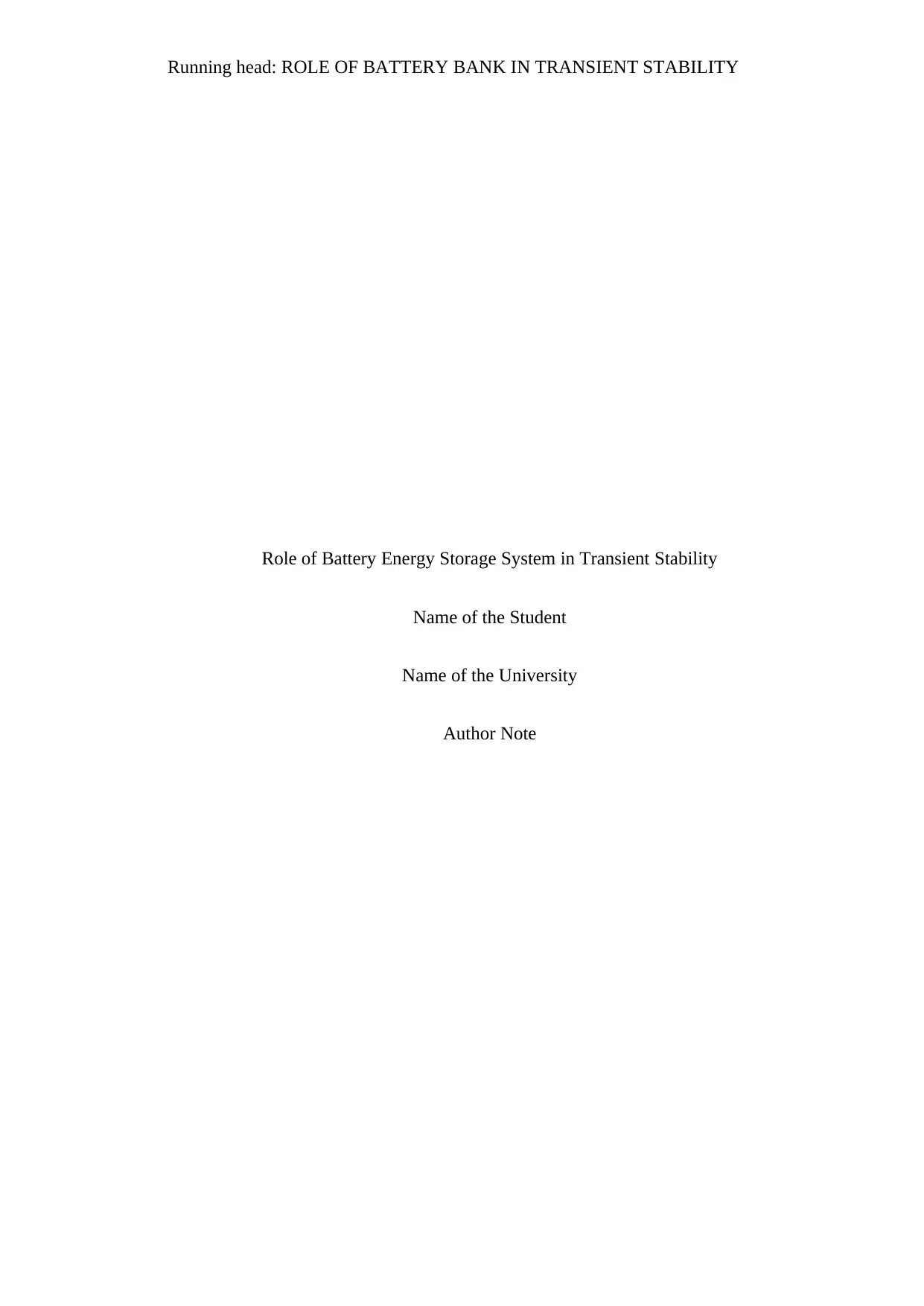
Running head: ROLE OF BATTERY BANK IN TRANSIENT STABILITY
Role of Battery Energy Storage System in Transient Stability
Name of the Student
Name of the University
Author Note
Role of Battery Energy Storage System in Transient Stability
Name of the Student
Name of the University
Author Note
Paraphrase This Document
Need a fresh take? Get an instant paraphrase of this document with our AI Paraphraser
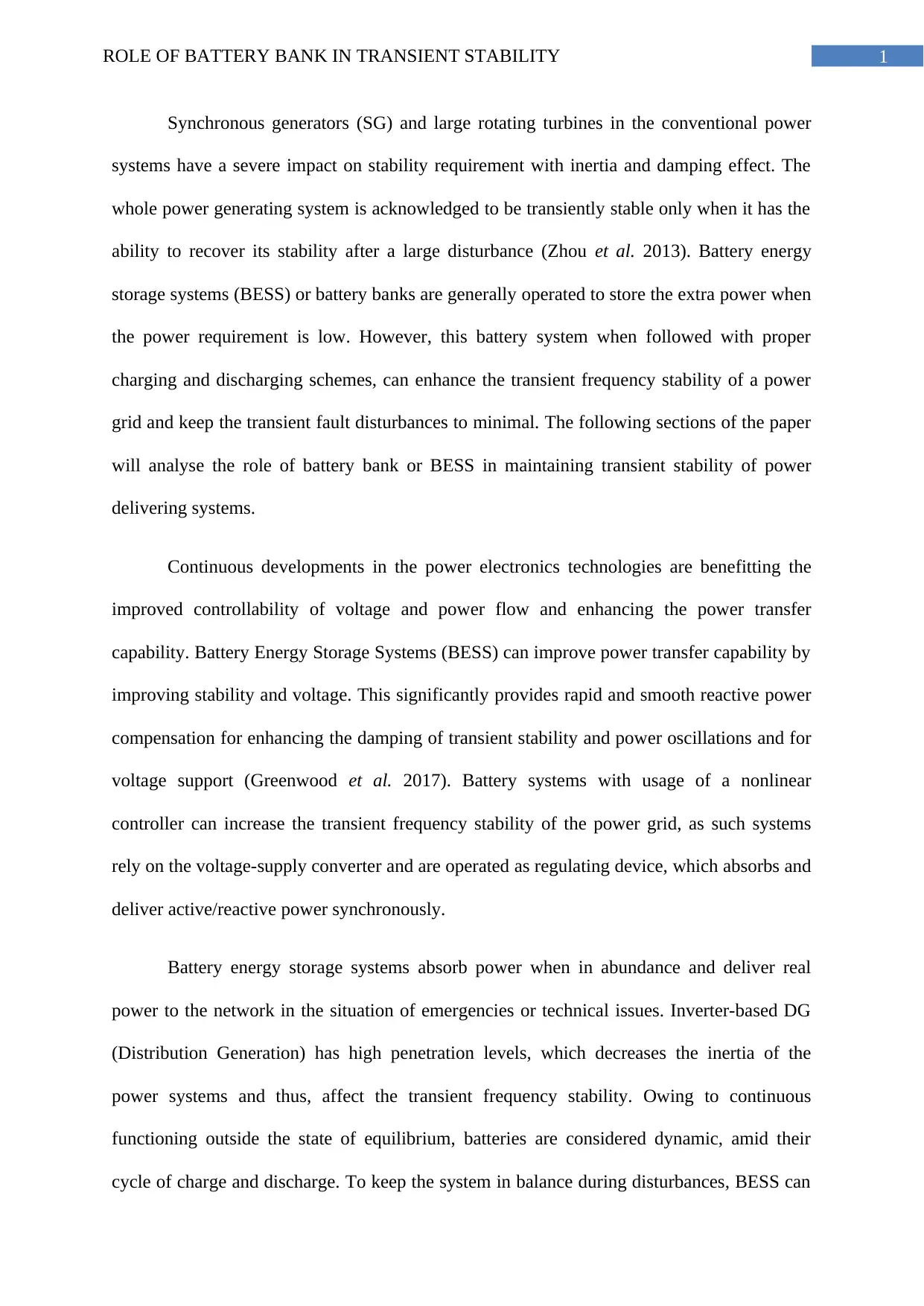
1ROLE OF BATTERY BANK IN TRANSIENT STABILITY
Synchronous generators (SG) and large rotating turbines in the conventional power
systems have a severe impact on stability requirement with inertia and damping effect. The
whole power generating system is acknowledged to be transiently stable only when it has the
ability to recover its stability after a large disturbance (Zhou et al. 2013). Battery energy
storage systems (BESS) or battery banks are generally operated to store the extra power when
the power requirement is low. However, this battery system when followed with proper
charging and discharging schemes, can enhance the transient frequency stability of a power
grid and keep the transient fault disturbances to minimal. The following sections of the paper
will analyse the role of battery bank or BESS in maintaining transient stability of power
delivering systems.
Continuous developments in the power electronics technologies are benefitting the
improved controllability of voltage and power flow and enhancing the power transfer
capability. Battery Energy Storage Systems (BESS) can improve power transfer capability by
improving stability and voltage. This significantly provides rapid and smooth reactive power
compensation for enhancing the damping of transient stability and power oscillations and for
voltage support (Greenwood et al. 2017). Battery systems with usage of a nonlinear
controller can increase the transient frequency stability of the power grid, as such systems
rely on the voltage-supply converter and are operated as regulating device, which absorbs and
deliver active/reactive power synchronously.
Battery energy storage systems absorb power when in abundance and deliver real
power to the network in the situation of emergencies or technical issues. Inverter-based DG
(Distribution Generation) has high penetration levels, which decreases the inertia of the
power systems and thus, affect the transient frequency stability. Owing to continuous
functioning outside the state of equilibrium, batteries are considered dynamic, amid their
cycle of charge and discharge. To keep the system in balance during disturbances, BESS can
Synchronous generators (SG) and large rotating turbines in the conventional power
systems have a severe impact on stability requirement with inertia and damping effect. The
whole power generating system is acknowledged to be transiently stable only when it has the
ability to recover its stability after a large disturbance (Zhou et al. 2013). Battery energy
storage systems (BESS) or battery banks are generally operated to store the extra power when
the power requirement is low. However, this battery system when followed with proper
charging and discharging schemes, can enhance the transient frequency stability of a power
grid and keep the transient fault disturbances to minimal. The following sections of the paper
will analyse the role of battery bank or BESS in maintaining transient stability of power
delivering systems.
Continuous developments in the power electronics technologies are benefitting the
improved controllability of voltage and power flow and enhancing the power transfer
capability. Battery Energy Storage Systems (BESS) can improve power transfer capability by
improving stability and voltage. This significantly provides rapid and smooth reactive power
compensation for enhancing the damping of transient stability and power oscillations and for
voltage support (Greenwood et al. 2017). Battery systems with usage of a nonlinear
controller can increase the transient frequency stability of the power grid, as such systems
rely on the voltage-supply converter and are operated as regulating device, which absorbs and
deliver active/reactive power synchronously.
Battery energy storage systems absorb power when in abundance and deliver real
power to the network in the situation of emergencies or technical issues. Inverter-based DG
(Distribution Generation) has high penetration levels, which decreases the inertia of the
power systems and thus, affect the transient frequency stability. Owing to continuous
functioning outside the state of equilibrium, batteries are considered dynamic, amid their
cycle of charge and discharge. To keep the system in balance during disturbances, BESS can
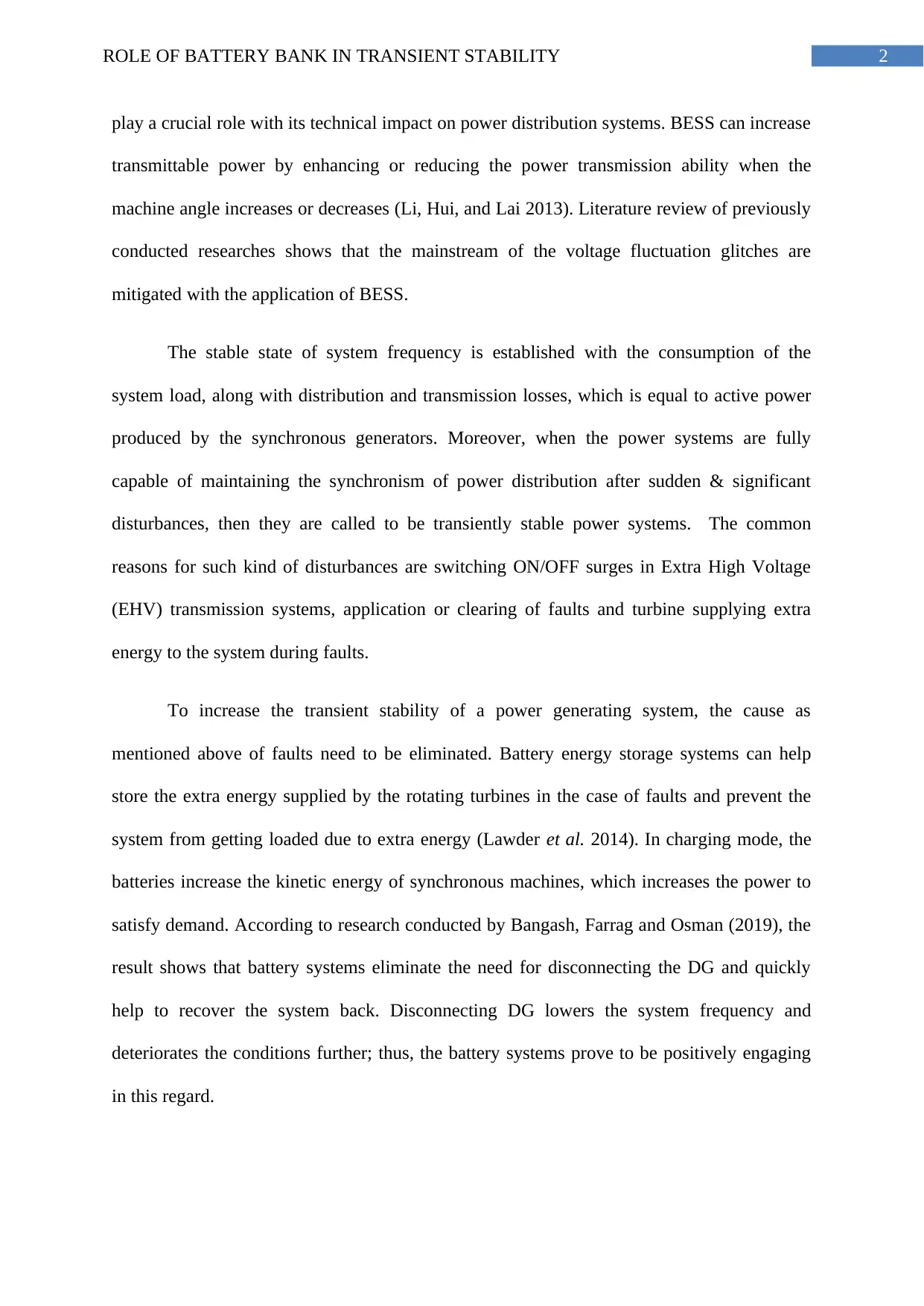
2ROLE OF BATTERY BANK IN TRANSIENT STABILITY
play a crucial role with its technical impact on power distribution systems. BESS can increase
transmittable power by enhancing or reducing the power transmission ability when the
machine angle increases or decreases (Li, Hui, and Lai 2013). Literature review of previously
conducted researches shows that the mainstream of the voltage fluctuation glitches are
mitigated with the application of BESS.
The stable state of system frequency is established with the consumption of the
system load, along with distribution and transmission losses, which is equal to active power
produced by the synchronous generators. Moreover, when the power systems are fully
capable of maintaining the synchronism of power distribution after sudden & significant
disturbances, then they are called to be transiently stable power systems. The common
reasons for such kind of disturbances are switching ON/OFF surges in Extra High Voltage
(EHV) transmission systems, application or clearing of faults and turbine supplying extra
energy to the system during faults.
To increase the transient stability of a power generating system, the cause as
mentioned above of faults need to be eliminated. Battery energy storage systems can help
store the extra energy supplied by the rotating turbines in the case of faults and prevent the
system from getting loaded due to extra energy (Lawder et al. 2014). In charging mode, the
batteries increase the kinetic energy of synchronous machines, which increases the power to
satisfy demand. According to research conducted by Bangash, Farrag and Osman (2019), the
result shows that battery systems eliminate the need for disconnecting the DG and quickly
help to recover the system back. Disconnecting DG lowers the system frequency and
deteriorates the conditions further; thus, the battery systems prove to be positively engaging
in this regard.
play a crucial role with its technical impact on power distribution systems. BESS can increase
transmittable power by enhancing or reducing the power transmission ability when the
machine angle increases or decreases (Li, Hui, and Lai 2013). Literature review of previously
conducted researches shows that the mainstream of the voltage fluctuation glitches are
mitigated with the application of BESS.
The stable state of system frequency is established with the consumption of the
system load, along with distribution and transmission losses, which is equal to active power
produced by the synchronous generators. Moreover, when the power systems are fully
capable of maintaining the synchronism of power distribution after sudden & significant
disturbances, then they are called to be transiently stable power systems. The common
reasons for such kind of disturbances are switching ON/OFF surges in Extra High Voltage
(EHV) transmission systems, application or clearing of faults and turbine supplying extra
energy to the system during faults.
To increase the transient stability of a power generating system, the cause as
mentioned above of faults need to be eliminated. Battery energy storage systems can help
store the extra energy supplied by the rotating turbines in the case of faults and prevent the
system from getting loaded due to extra energy (Lawder et al. 2014). In charging mode, the
batteries increase the kinetic energy of synchronous machines, which increases the power to
satisfy demand. According to research conducted by Bangash, Farrag and Osman (2019), the
result shows that battery systems eliminate the need for disconnecting the DG and quickly
help to recover the system back. Disconnecting DG lowers the system frequency and
deteriorates the conditions further; thus, the battery systems prove to be positively engaging
in this regard.
⊘ This is a preview!⊘
Do you want full access?
Subscribe today to unlock all pages.

Trusted by 1+ million students worldwide

3ROLE OF BATTERY BANK IN TRANSIENT STABILITY
However, the primary concern of using a battery bank to improve transient stability is
that they degrade faster. When the same Battery energy storage system participates in grid
operations such as frequency regulation, peak shaving and demand response, faster
degradation of the system can be observed. However, a joint optimisation framework
proposing the application of BESS in both frequency regulation and peak shaving for
commercial customers will result in larger cost-savings (Shi et al., 2018). The research
concludes that commercial customers can save more when they use a single battery for
several purposes instead of dedicating the batteries to a solo application.
Transient stability of the renewable energy DG is reduced with the intervention of
high-penetration inverter-based Distribution Generation, which finally results in less kinetic
energy and low inertia. The fast switching of different modes of battery, i.e. charging and
discharging can resynchronize the system and regain stability when power from renewable
distributed generation is lost. When the coupling is missing between mechanical damping and
electrical damping, significant power oscillations under faulty conditions in the systems can
be observed. One way to ensure very less damage to the power system is to provide
additional damping through coupling between mechanical subsystems (SGs) and electrical
subsystems (Battery). This is completed by selecting appropriate damping structure and
suitable interconnection in the close-looped system. BESS by improving voltage regulations
and power factor can help to damp electromechanical oscillations, which further enhances
transient stability caused by faulty conditions (Zhu et al. 2018). Thus, the various divergent
roles that BESS plays in a power system are damping improvements in electro-mechanical
power oscillations, improving transient stability and providing power and voltage quality
support (Alipoor, Miura and Ise 2015). Various researches have shown that battery energy
storage systems have better damping effect than power system stabilisers. BESS incorporated
with lead-lag validates better results compared to PI-lead and conventional PI controllers in
However, the primary concern of using a battery bank to improve transient stability is
that they degrade faster. When the same Battery energy storage system participates in grid
operations such as frequency regulation, peak shaving and demand response, faster
degradation of the system can be observed. However, a joint optimisation framework
proposing the application of BESS in both frequency regulation and peak shaving for
commercial customers will result in larger cost-savings (Shi et al., 2018). The research
concludes that commercial customers can save more when they use a single battery for
several purposes instead of dedicating the batteries to a solo application.
Transient stability of the renewable energy DG is reduced with the intervention of
high-penetration inverter-based Distribution Generation, which finally results in less kinetic
energy and low inertia. The fast switching of different modes of battery, i.e. charging and
discharging can resynchronize the system and regain stability when power from renewable
distributed generation is lost. When the coupling is missing between mechanical damping and
electrical damping, significant power oscillations under faulty conditions in the systems can
be observed. One way to ensure very less damage to the power system is to provide
additional damping through coupling between mechanical subsystems (SGs) and electrical
subsystems (Battery). This is completed by selecting appropriate damping structure and
suitable interconnection in the close-looped system. BESS by improving voltage regulations
and power factor can help to damp electromechanical oscillations, which further enhances
transient stability caused by faulty conditions (Zhu et al. 2018). Thus, the various divergent
roles that BESS plays in a power system are damping improvements in electro-mechanical
power oscillations, improving transient stability and providing power and voltage quality
support (Alipoor, Miura and Ise 2015). Various researches have shown that battery energy
storage systems have better damping effect than power system stabilisers. BESS incorporated
with lead-lag validates better results compared to PI-lead and conventional PI controllers in
Paraphrase This Document
Need a fresh take? Get an instant paraphrase of this document with our AI Paraphraser
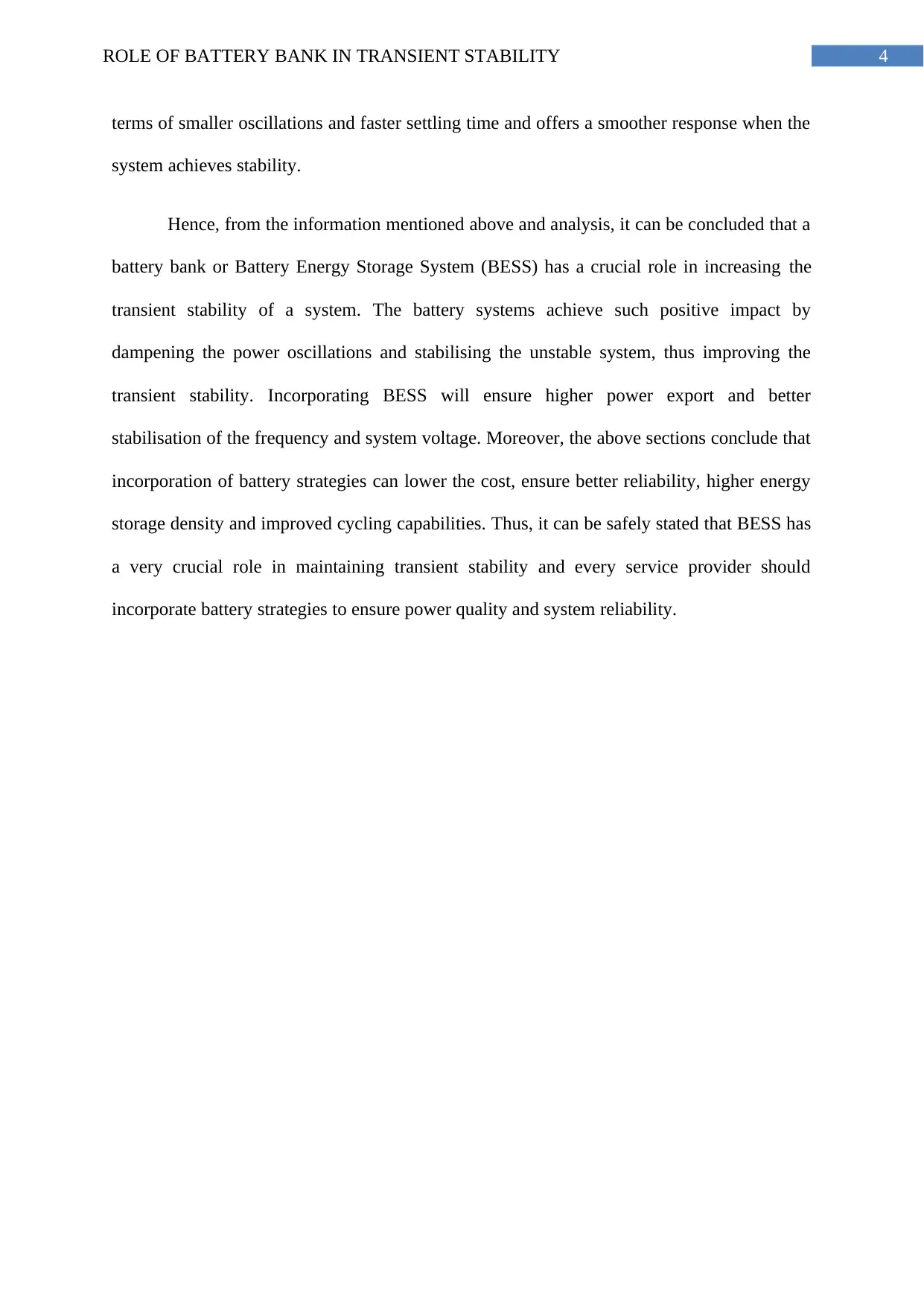
4ROLE OF BATTERY BANK IN TRANSIENT STABILITY
terms of smaller oscillations and faster settling time and offers a smoother response when the
system achieves stability.
Hence, from the information mentioned above and analysis, it can be concluded that a
battery bank or Battery Energy Storage System (BESS) has a crucial role in increasing the
transient stability of a system. The battery systems achieve such positive impact by
dampening the power oscillations and stabilising the unstable system, thus improving the
transient stability. Incorporating BESS will ensure higher power export and better
stabilisation of the frequency and system voltage. Moreover, the above sections conclude that
incorporation of battery strategies can lower the cost, ensure better reliability, higher energy
storage density and improved cycling capabilities. Thus, it can be safely stated that BESS has
a very crucial role in maintaining transient stability and every service provider should
incorporate battery strategies to ensure power quality and system reliability.
terms of smaller oscillations and faster settling time and offers a smoother response when the
system achieves stability.
Hence, from the information mentioned above and analysis, it can be concluded that a
battery bank or Battery Energy Storage System (BESS) has a crucial role in increasing the
transient stability of a system. The battery systems achieve such positive impact by
dampening the power oscillations and stabilising the unstable system, thus improving the
transient stability. Incorporating BESS will ensure higher power export and better
stabilisation of the frequency and system voltage. Moreover, the above sections conclude that
incorporation of battery strategies can lower the cost, ensure better reliability, higher energy
storage density and improved cycling capabilities. Thus, it can be safely stated that BESS has
a very crucial role in maintaining transient stability and every service provider should
incorporate battery strategies to ensure power quality and system reliability.
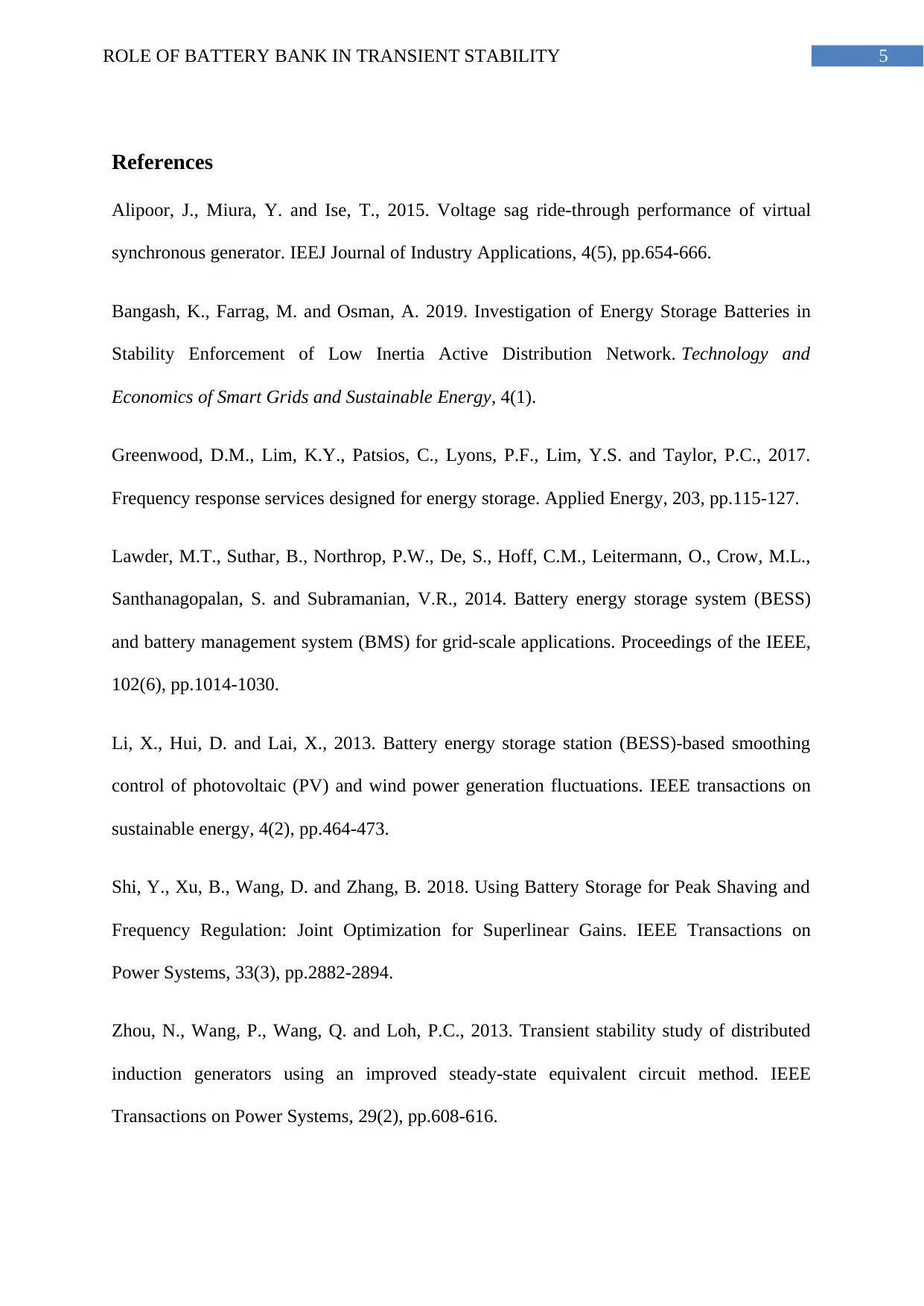
5ROLE OF BATTERY BANK IN TRANSIENT STABILITY
References
Alipoor, J., Miura, Y. and Ise, T., 2015. Voltage sag ride-through performance of virtual
synchronous generator. IEEJ Journal of Industry Applications, 4(5), pp.654-666.
Bangash, K., Farrag, M. and Osman, A. 2019. Investigation of Energy Storage Batteries in
Stability Enforcement of Low Inertia Active Distribution Network. Technology and
Economics of Smart Grids and Sustainable Energy, 4(1).
Greenwood, D.M., Lim, K.Y., Patsios, C., Lyons, P.F., Lim, Y.S. and Taylor, P.C., 2017.
Frequency response services designed for energy storage. Applied Energy, 203, pp.115-127.
Lawder, M.T., Suthar, B., Northrop, P.W., De, S., Hoff, C.M., Leitermann, O., Crow, M.L.,
Santhanagopalan, S. and Subramanian, V.R., 2014. Battery energy storage system (BESS)
and battery management system (BMS) for grid-scale applications. Proceedings of the IEEE,
102(6), pp.1014-1030.
Li, X., Hui, D. and Lai, X., 2013. Battery energy storage station (BESS)-based smoothing
control of photovoltaic (PV) and wind power generation fluctuations. IEEE transactions on
sustainable energy, 4(2), pp.464-473.
Shi, Y., Xu, B., Wang, D. and Zhang, B. 2018. Using Battery Storage for Peak Shaving and
Frequency Regulation: Joint Optimization for Superlinear Gains. IEEE Transactions on
Power Systems, 33(3), pp.2882-2894.
Zhou, N., Wang, P., Wang, Q. and Loh, P.C., 2013. Transient stability study of distributed
induction generators using an improved steady-state equivalent circuit method. IEEE
Transactions on Power Systems, 29(2), pp.608-616.
References
Alipoor, J., Miura, Y. and Ise, T., 2015. Voltage sag ride-through performance of virtual
synchronous generator. IEEJ Journal of Industry Applications, 4(5), pp.654-666.
Bangash, K., Farrag, M. and Osman, A. 2019. Investigation of Energy Storage Batteries in
Stability Enforcement of Low Inertia Active Distribution Network. Technology and
Economics of Smart Grids and Sustainable Energy, 4(1).
Greenwood, D.M., Lim, K.Y., Patsios, C., Lyons, P.F., Lim, Y.S. and Taylor, P.C., 2017.
Frequency response services designed for energy storage. Applied Energy, 203, pp.115-127.
Lawder, M.T., Suthar, B., Northrop, P.W., De, S., Hoff, C.M., Leitermann, O., Crow, M.L.,
Santhanagopalan, S. and Subramanian, V.R., 2014. Battery energy storage system (BESS)
and battery management system (BMS) for grid-scale applications. Proceedings of the IEEE,
102(6), pp.1014-1030.
Li, X., Hui, D. and Lai, X., 2013. Battery energy storage station (BESS)-based smoothing
control of photovoltaic (PV) and wind power generation fluctuations. IEEE transactions on
sustainable energy, 4(2), pp.464-473.
Shi, Y., Xu, B., Wang, D. and Zhang, B. 2018. Using Battery Storage for Peak Shaving and
Frequency Regulation: Joint Optimization for Superlinear Gains. IEEE Transactions on
Power Systems, 33(3), pp.2882-2894.
Zhou, N., Wang, P., Wang, Q. and Loh, P.C., 2013. Transient stability study of distributed
induction generators using an improved steady-state equivalent circuit method. IEEE
Transactions on Power Systems, 29(2), pp.608-616.
⊘ This is a preview!⊘
Do you want full access?
Subscribe today to unlock all pages.

Trusted by 1+ million students worldwide
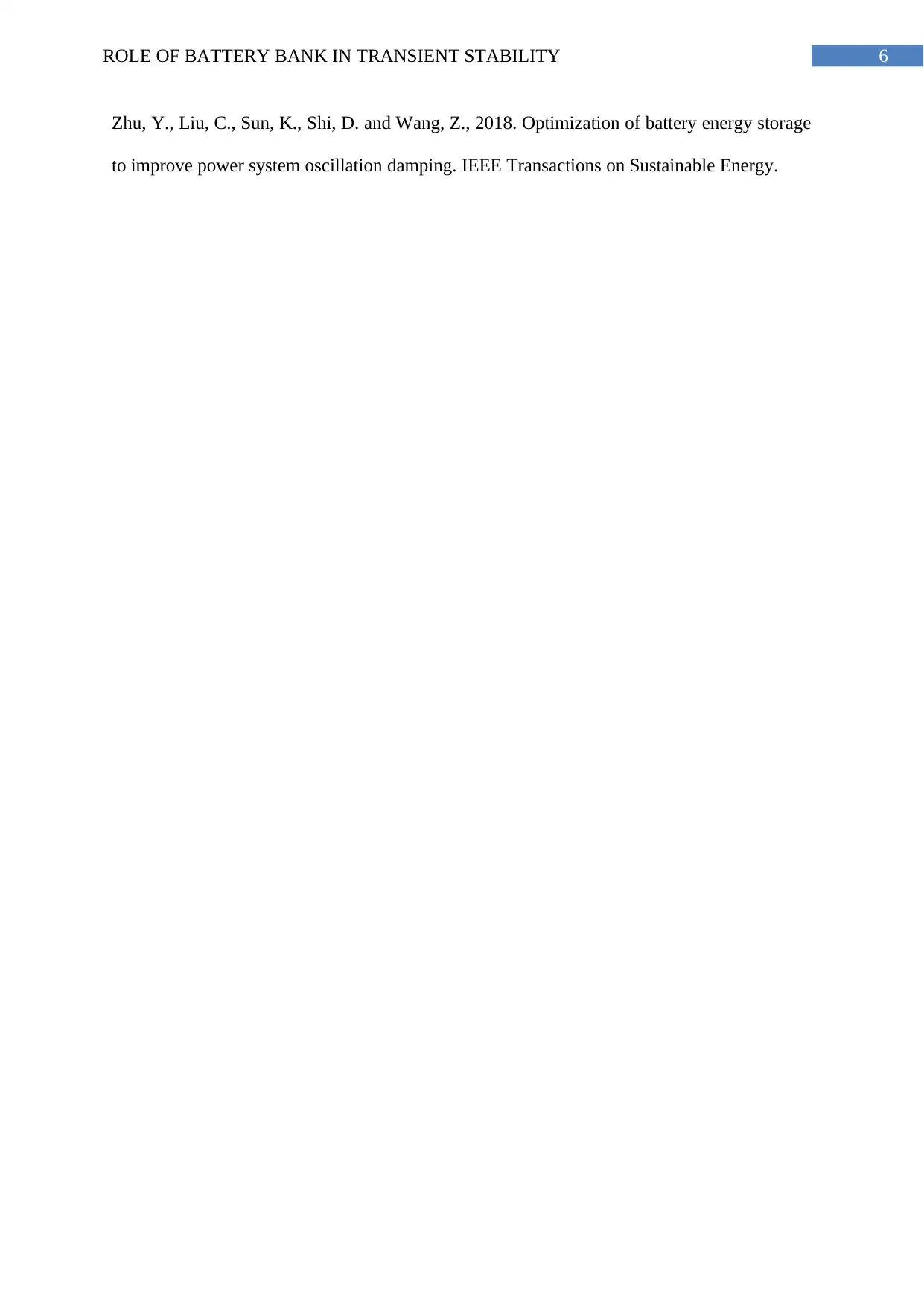
6ROLE OF BATTERY BANK IN TRANSIENT STABILITY
Zhu, Y., Liu, C., Sun, K., Shi, D. and Wang, Z., 2018. Optimization of battery energy storage
to improve power system oscillation damping. IEEE Transactions on Sustainable Energy.
Zhu, Y., Liu, C., Sun, K., Shi, D. and Wang, Z., 2018. Optimization of battery energy storage
to improve power system oscillation damping. IEEE Transactions on Sustainable Energy.
1 out of 7
Related Documents
Your All-in-One AI-Powered Toolkit for Academic Success.
+13062052269
info@desklib.com
Available 24*7 on WhatsApp / Email
![[object Object]](/_next/static/media/star-bottom.7253800d.svg)
Unlock your academic potential
Copyright © 2020–2026 A2Z Services. All Rights Reserved. Developed and managed by ZUCOL.





